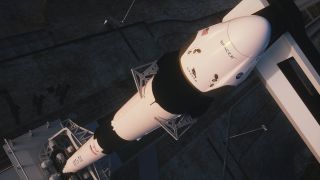SpaceX is gearing up for a major Crew Dragon test flight this week, one that — if it goes well — will mark the final major milestone before the company launches astronauts into space.
On Saturday (Jan. 18), SpaceX will launch an uncrewed Crew Dragon capsule atop a Falcon 9 rocket on a critical flight test of the spacecraft’s emergency abort system. The test, called an in-flight abort, will prove Crew Dragon’s abort system can pull astronaut crews to safety in the event of a rocket failure during launch.
“Critical test launch before flying astronauts is green for Jan. 18,” SpaceX CEO Elon Musk wrote on Twitter Saturday (Jan. 11) as the company test-fired the mission’s Falcon 9 at Launch Pad 39A of NASA’s Kennedy Space Center in Florida. Liftoff is set for 8 a.m. EST (1300 GMT), NASA has said.
Video: How SpaceX’s In-Flight Abort Crew Dragon Launch Will Work
More: Watch SpaceX’s Crew Dragon Abort System in Close-Up Action

SpaceX needs this test to go well to show that Crew Dragon is ready to launch NASA astronauts Bob Behnken and Doug Hurley to the International Space Station on a crewed flight test later this year. The company launched an uncrewed Crew Dragon to the station in March 2019, on a successful mission called Demo-1. But that capsule exploded during work on ground tests of the abort system a month later.
After upgrades to prevent a similar failure from happening again, SpaceX performed a series of ground-based abort system tests that cleared the way for Saturday’s test.
SpaceX’s Crew Dragon is equipped with eight abort engines, called SuperDracos, to blast the space capsule free of its Falcon 9 during an emergency. During Saturday’s test, that will happen about 90 seconds after liftoff, after which the Falcon 9’s first stage engines will shut down.
After Crew Dragon reaches the peak of its arc, it will jettison its cylindrical trunk and deploy four parachutes as it falls back to Earth to splash down in the Atlantic Ocean. From start to finish, the test flight should take less than 12 minutes.
SpaceX’s GO Searcher recovery ship will be on hand to retrieve the Crew Dragon, but don’t expect to see an awesome rocket landing. SpaceX does not expect the rocket to survive Crew Dragon’s separation from the booster.
“Destroyed in Dragon fire,” Musk said on Twitter when asked about the rocket’s fate.
In Photos: NASA Practices Emergency Astronaut Recovery with SpaceX, Boeing
NASA wants to use Saturday’s launch as a dress rehearsal of sorts for actual crew launches by SpaceX.
“Prior to launch, SpaceX and NASA teams will practice launch day end-to-end operations with NASA astronauts, including final spacecraft inspections and side hatch closeout,” NASA officials said in a statement.
SpaceX is one of two companies with multibillion-dollar contracts to fly NASA astronauts to and from the International Space Station on commercial spacecraft. The other company, Boeing, will use a capsule called Starliner to make those taxi flights for NASA.
Just as SpaceX moved closer to human spaceflight in 2019, so, too, did Boeing. The company launched the first Starliner spacecraft Dec. 20 on an uncrewed test flight to the space station, but Starliner suffered a mission clock error that prevented it from reaching the orbiting lab. It returned to Earth safely on Dec. 22.
“I’m looking forward to kicking off the new year with this big Crew Dragon milestone,” Behnken wrote on Twitter.
Editor’s note: You can watch SpaceX’s Crew Dragon in-flight abort test launch live on Space.com Saturday, Jan. 18, beginning at 7:45 a.m. EST (1245 GMT). Liftoff is scheduled for 8 a.m. EST (1300 GMT).
Email Tariq Malik at tmalik@space.com or follow him @tariqjmalik. Follow us @Spacedotcom and Facebook.







